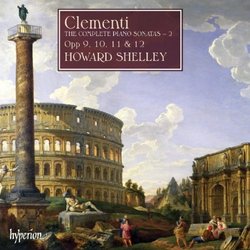| All Artists: Muzio Clementi, Howard Shelley Title: Clementi: The Complete Piano Sonatas, Vol. 2 Members Wishing: 1 Total Copies: 0 Label: Hyperion UK Original Release Date: 1/1/2008 Re-Release Date: 9/9/2008 Album Type: Import Genre: Classical Styles: Chamber Music, Forms & Genres, Sonatas, Historical Periods, Classical (c.1770-1830) Number of Discs: 2 SwapaCD Credits: 2 UPC: 034571177175 |
Search - Muzio Clementi, Howard Shelley :: Clementi: The Complete Piano Sonatas, Vol. 2
 | Muzio Clementi, Howard Shelley Clementi: The Complete Piano Sonatas, Vol. 2 Genre: Classical |
Larger Image |
CD Details |
CD ReviewsShelley's Clementi series continues--the bar remains high! Dace Gisclard | Houston, TX | 10/15/2008 (5 out of 5 stars) "The second installment of Howard Shelley's Clementi sonata series is finally here, and well worth the wait. Replying to a comment on my review of Vol.I, I remarked that I expected Op.12 would be the highlight of this volume. This proves to be only partially true--Shelley's imaginatively nuanced, effervescent Op.9 was an unexpected delight, leaving me with newfound admiration of works I had hitherto undervalued. Perhaps Opera 10 and 11 are more for the Clementi completist than the casual listener, but there are plenty of treasures here.
The brilliant yet genial Toccata that forms the second part of Op.11 is a work the composer played in Mozart's presence during their infamous meeting in Vienna. It, like many of the other pieces herein, bristles with Clementi's (by now customary) rapid double- and triple-notes. It's understandable that Mozart must have felt a bit uncomfortable! Each successive sonata of Op.12 gets a bit fuller in texture, until No.4, where, here and there, strenuous leaps in full chords presage the richness of Brahms. Here, too, the slow movements have a newfound emotional depth. As for the performer, Shelley plays Clementi (I can think of no other way to put this) like a "real composer," not like a footnote in a musicology text! There is no "early music" preciousness, no fussy theorizing--only robust, wholesome and communicative music-making. Clementi's individual voice is allowed to ring forth without making him sound like a Haydn-Mozart "also-ran." Neither is there any apologizing for passages Clementi obviously designed to sizzle and impress with virtuosity. In reading through many of these sonatas myself, I have often wondered how Spada and Tipo could have missed things Shelley brings out when they are so obviously there on the page: i.e., extended passages of melancholy and brief rhythmically free "cadenzas" tempering the dazzle of quicker movements thereby lending them greater substance; not merely repeating parallel phrases, but inflecting them with different dynamics and pacing. Spada and Tipo usually ignored such opportunities--Shelley gives us creative imagination, passion, whimsy and wit. If this sounds like Shelley indulges in unfettered romanticizing, such is not the case. His liberties are always within period style. WARNING: PARAGRAPH OF GEEKY MUSICOLOGY DETAIL FOLLOWS! SKIP AHEAD IF YOU'RE ALLERGIC! Further, Shelley plays the trills correctly (hoodathunkit?), beginning on the UPPER note (hot dawg!). In his "Introduction to the Art of Playing on the Pianoforte," Clementi specifies that both brief (passing) trills, and trills approached legato and stepwise, may begin, at the performer's discretion and good taste, on the main note. Otherwise, the default is that ALL trills begin on the upper note. Spada (the Clementi scholar and editor, who should know better) makes Clementi's trill exceptions the rule, misinterpreting the composer's intentions by beginning almost every trill on the main note, whether approached stepwise or not (what??!!). The lack of emphasis on the dissonant upper note, so typical of classical period trills, paradoxically becomes jarring by its very flatness. Adding to the attractiveness of this series are notes by Leon Plantinga, a foremost authority on the composer. I highly and warmly recommend Shelley's series, but the best is yet to come! Other volumes in this series: Vol.I Clementi: The Complete Piano Sonatas, Vol. 1 Vol.III Piano Sonatas 3 Vol.IV Piano Sonatas 4 Vol.V Clementi: Piano Sonatas - Vol.5" |
